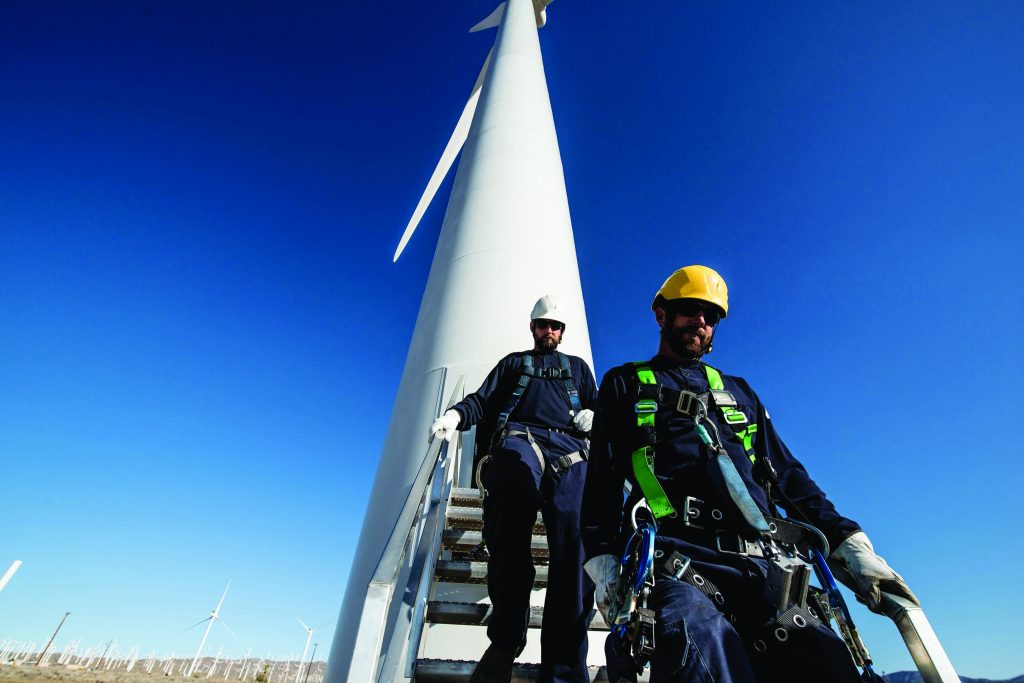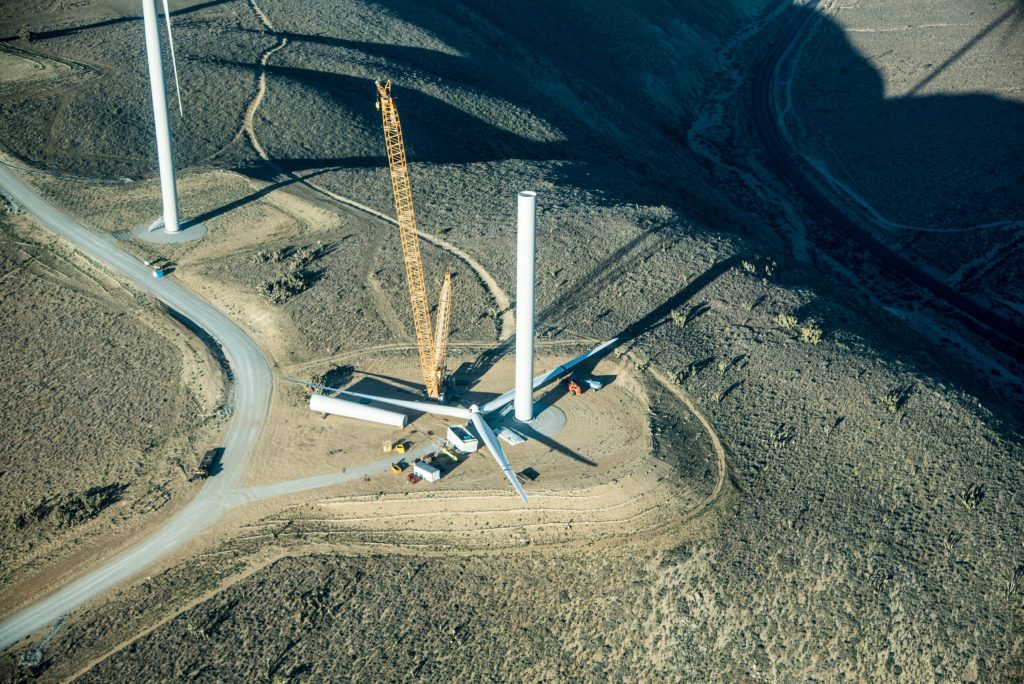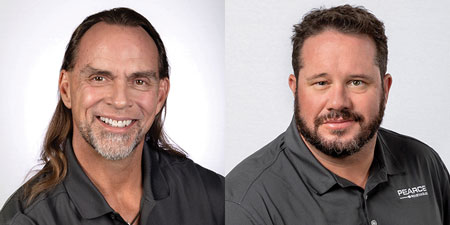What does Pearce Renewables do for the wind sector?
Dees: Pearce Renewables focuses on the wind turbine — PMs, CMs, major correctives, demo, blade repair. We are not an EPC contractor — but we’ll do some site remediation, and anytime there’s a big flood, we have the ability to go in and do BMPs. In the MCE world, we’re probably the largest ISP out there. In terms of headcount, we’re the largest provider in the wind sector. Our services business focuses on PMs and CMs. Our MCE team handles anything from blade bearing to hub replacements and complete repower replacements, if needed.
We also do turbine demos in which we take the turbine apart, cut the towers down, and do a full decommissioning. We do everything under the sun for blade repair. We can take the blade off, repair it, and do rope access, basket work, and condition monitoring. We have some wind farms where we do full care and custody. We can either serve as the O&M contractor for the owner or we can deploy a maintenance program. At the end of the day, we’re responsible for production as well as monitoring the system.
 What does it mean to be an independently authorized GWO training provider?
What does it mean to be an independently authorized GWO training provider?
Dees: It lets us internally train all of our technicians to the high Global Wind Organization (GWO) training standard. We like to know that, with our program and being independent, our guys are all trained the same way, which makes it easier for them to work together. We have the confidence that they’re qualified, certified, and have the skills to rescue each other in the event of an incident or emergency. Having the GWO certification lets us work with that program while fitting those standards to our specific site contexts. When you’re not independent, you have to use somebody else’s curriculum regardless of whether that meets your specific needs. We’re able to make tweaks and adjustments that best suit our requirements, ensuring that our techs get the best safety and technical training.
Hornbeck: In other words, combining independence with the GWO authorization allows us to improve the training. They’re proof that we meet the highest standards and that we’ve passed all the rigorous audits. After meeting those standards, if we want to improve on, say, bolt torquing, we have the freedom to train employees and provide what most other training providers don’t offer. It’s that little extra that instills confidence in customers, who understand that our team is trained specifically in bolt tightening under the top industry standards. This degree of industry recognition lets our customers know we’re the best and safest provider available.
What are some of the benefits of standardizing training practices across the wind industry?
Dees: The most significant benefit of GWO standardized training is that everyone’s getting the same training and everyone knows how to use the same equipment. If you’re up a tower with your client and you’re all trained through the GWO standard, you know that they have enough training to get you down-tower safely if something were to happen.
That’s first and foremost.
When you get on site, you know the team has had electrical training, so they should know how to bottle out an electrical component. They’ve got torquing training, so they know how to use torque wrenches and hydraulic torquing. Everyone’s been trained to the same standard. You’re not out there with a greenhorn who’s never done anything before, making them a safety hazard. Following these standards allows us to ensure complete risk mitigation.
It’s tough. Our job is done 800 feet in the air, so it’s critical that the technicians have that sense of safety. If you’re up there with someone who doesn’t have the proper training — or just the basic tower climb training — you could be facing serious repercussions if something happens. It can take a while for an emergency response — especially if you’re waiting on the fire department or emergency call-out service. They may be hours away in some cases.
By being trained to the same standard, everyone can get down safely with a baseline general understanding of how to use the tools correctly.
Hornbeck: Along with that safety and qualified work, standardization elevates the expertise we send to the job site. It reduces cost and reduces time, enhancing our ability to take care of our customers. It increases productivity, meaning job speed-to-completion is faster. It’s a significant improvement overall.
 What was required to become a training provider?
What was required to become a training provider?
Dee: Before we acquired our wind division, Pearce partnered with an outside company for GWO training. We used their curriculum exclusively and followed their guidelines, which mirrored those provided by the GWO. Eventually we built our own training curriculum based on the GWO guidelines.
Understanding that, the auditing process is extremely rigorous, almost like an ISO certification on the backend. GWO has to watch each trainer deliver the modules individually; they watch trainers do the actual hands-on portion as well.
On the backend, they’re auditing all your paperwork: Is everything in place? Do you have a system to track it? How do you get your certifications? Where do they reside? How do your techs access the training? It’s quite a process. It took us three months just to prepare for the audit. During the one-week audit itself, they identify any non-conformities — from the minor to the serious. After you correct them, the auditors sign off, send all the info to GWO, and ultimately the organization issues the certification.
Hornbeck: What’s good about that process is they also critique our instructors. They literally watch our instructors teach classes and look at our equipment to make sure it meets or exceeds industry standards.
At Pearce, we always aim to exceed standards. We’ve built our curriculum to double the minimum requirements wherever possible. Our audits were very successful, and we enhanced our understanding during the process. Our team is proud of this accomplishment.
How does this affect how Pearce interacts with its clients now? What’s changed since you’ve had this happen?
Hornbeck: Our clients prefer to use independent authorized trainers instead of a GWO trainer under the auspices of another company. They know that independents have the freedom and the trust from the GWO to train above the standards.
How does being a GWO training provider better enable you to address the industry’s workforce development challenges?
Dees: At Pearce, we’re a manpower-driven company. Having the GWO certification gives us the ability to accelerate training and increase our manpower, not just for our wind techs but all of our techs. It drives our career path. Part of our retention program is giving technicians an opportunity for a career in the renewables industry. The only way we can do that is to provide them a career path. So, as a tech, they come in, they get basic safety training, and they go out in the field, work with their peers and with lead techs, and get more time on the turbine.
Having all the standards in place allows us to chart a path forward for our technicians, providing them the training they’ll get along the way to advance and succeed. While everyone wants to earn a good living, we understand the motivational impact of career growth.And if you use just the GWO training pieces, you can see that when you get BST, you’re a Tech 1. Once you have Basic Safety Training (BST) and Basic Technical Training (BTT), you’re a Tech 2; you get BST, BTT, Advanced Rescue Training (ART), and soon you’re at that Tech 3 level. All technicians are shown a career path presentation when they’re hired so they can see the potential. We pay for many team members to pursue OEM training so that they can learn about commissioning new technology.
Hornbeck: It gives them a sense of pride. The technicians are proud to hold these certifications. It’s a great thing for morale and workforce retention. They have clear goals to work toward.
What else is happening in training at Pearce?
Hornbeck: We’re growing. We’re adding new training modules all the time. As an independent, we can add new training modules quickly and efficiently to keep career development going.
Dees: We’ve outgrown our Tehachapi facility in California, and we’re in the process of getting a second facility in Dallas, Texas, up and operational. The goal is to have two full-blown GWO training centers by Q1 2024. We have a 40-foot trailer in Tehachapi that we use; it also will be GWO-certified. We can now travel to sites where we have techs and perform GWO training through the travel trailer. This is a great step, but we’ve got even better things coming. We’re just getting started.
More info www.pearce-renewables.com




























